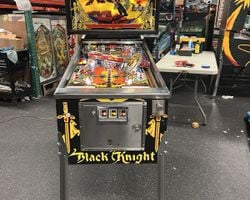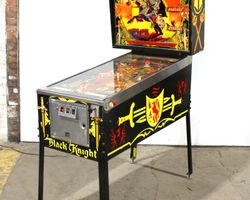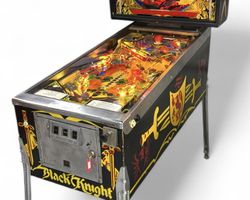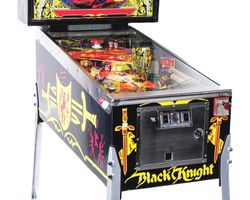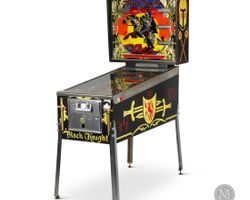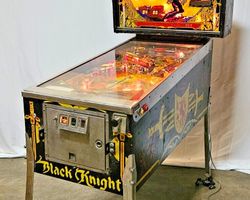Black Knight
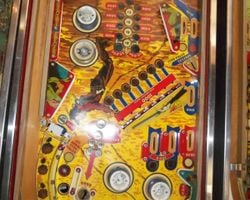
Average Prices: USD $500 to $2,300
Produced: November, 1980
Production Run: 13,075 units
Machine Type: Solid State Electronic
MPU: Williams System 7
Players: 4
Design by: Steve Ritchie
Art by: Tony Ramunni
Software by: Larry DeMar
Williams Electronics, Incorporated, a significant name in pinball manufacturing, unveiled the "Black Knight" in November 1980. This machine represented a pivotal moment, pushing the boundaries of what pinball could be. Its theme, a dark medieval fantasy centering around a formidable Black Knight, captured the imagination, drawing players into a world of chivalry and challenge. The inspiration stemmed from a desire to create a game that was not only engaging but also visually and mechanically groundbreaking.
The design and production of "Black Knight" were spearheaded by a team that included industry luminaries. Steve Ritchie, the game's principal designer, was also responsible for its mechanical engineering and conceptualization, lending his distinctive vision to every aspect. Notably, Ritchie also provided the commanding voice for the titular character, imbuing the machine with an unparalleled sense of direct interaction. Tony Ramunni crafted the evocative artwork, bringing the medieval theme to life on the playfield and backglass. Larry DeMar handled the intricate software and electronics, ensuring the machine's complex features functioned seamlessly. John Kotlarik composed the soundscape, complementing the visual and mechanical elements with memorable auditory cues.
"Black Knight" was part of Williams' System 7 generation, a robust platform that allowed for greater complexity and innovation in pinball design. With a production run of 13,075 units, its market impact was substantial. It quickly established itself as a commercial success and a testament to Williams' forward-thinking approach. An interesting detail from its production history reveals a mid-run change: the transformer, initially located in the backbox, was later moved to the lower cabinet, necessitating a power supply board revision. Early production units also featured a specific System 6 power board, underscoring the continuous refinement that occurred even during manufacturing. Furthermore, a unique pre-production backglass exists, owned for many years by Steve Ritchie, showcasing the Black Knight's armor in a teal hue rather than the production gray, alongside a distinct artist's signature.
Redefining Pinball Interaction: Signature Features and Design
"Black Knight" introduced several standout features that forever changed pinball design, setting new benchmarks for player engagement. Foremost among these was the "Magna-Save" system. This innovative feature provided players with an active defense mechanism: by pressing a dedicated button on either side of the cabinet, a powerful electromagnet in the outlane would momentarily activate, preventing a ball from draining. The ball would be held and then dropped into the inlane, giving the player a crucial second chance. This not only added a layer of strategy but also created a palpable tension, requiring players to time their saves precisely and manage their Magna-Save activations.
Another pioneering element was the multi-level playfield. While multi-level designs had existed in electro-mechanical games decades prior, "Black Knight" was the first solid-state pinball machine to incorporate such a feature. This split-level design introduced verticality and new shot opportunities, making the playfield feel expansive and dynamic. The three ramps, leading to and from the upper playfield, were integral to this design, creating a fluid transition between the two playing surfaces.
The machine also marked the debut of faceted inserts in the playfield. These transparent plastic windows, designed with an eight-sided "Jewel Look," enhanced the visual appeal of the playfield lighting, creating a shimmering effect as lights flashed beneath them. This seemingly minor detail contributed significantly to the machine's overall aesthetic and became a standard design element in subsequent pinball machines, evolving into various textures and patterns. These innovations, collectively, demonstrated a commitment to pushing technological and design boundaries, enhancing both gameplay mechanics and the overall immersive experience for players.
Strategic Terrain: Playfield and Mechanics
The "Black Knight" playfield is a masterful arrangement of targets, ramps, and interactive elements, meticulously designed to create a challenging yet rewarding experience. The layout prominently features a two-level design, with a distinct upper playfield accessible via ramps. The main playfield is dominated by four banks of 3-bank drop targets, totaling twelve, which are central to scoring and progression. Two kick-out holes offer additional objective variety, while a single pop bumper keeps the ball in chaotic motion near the top of the lower playfield. A spinning target and two slingshots add to the interactive elements, providing kinetic feedback and changing ball trajectories.
The flow of "Black Knight" encourages aggressive, direct shots. The two-way right ramps provide routes to and from the upper playfield, creating satisfying loops. The left horseshoe lane, a critical shot, also connects to the upper playfield. The four flippers, two on the lower playfield and two on the upper, allow for strategic control across both levels. The design philosophy emphasizes target-based gameplay, requiring precision and repetition to clear the drop target banks, which often reset, presenting a continuous challenge.
Tony Ramunni's artwork on the playfield and backglass is a striking embodiment of the medieval fantasy theme. Dark, rich colors dominate, with the menacing Black Knight figure prominently featured. The lighting, integrated with the faceted inserts, accentuates key targets and paths, guiding the player's eye while also contributing to the dramatic atmosphere. The overall aesthetic is cohesive and immersive, reinforcing the theme of a relentless adversary and a quest for high scores.
Confronting the Knight: Gameplay Dynamics
"Black Knight" delivers a gameplay experience focused on skill, precision, and strategic decision-making. The core objective revolves around hitting the numerous drop targets. Clearing these banks is crucial for scoring and advancing game features. The game's progression is straightforward yet deeply engaging, demanding consistent accuracy.
Unique to "Black Knight" are its multiball modes, offering both 2-ball and 3-ball multiball play. Initiating multiball activates score multipliers, transforming ordinary shots into high-scoring opportunities and creating intense, high-energy sequences. A loop bonus multiplier further rewards players for successive shots through the critical loop ramp, encouraging a rhythm of high-value plays.
The Magna-Save mechanism introduces a tactical layer, requiring players to conserve and strategically deploy their saves. Mastering this feature, knowing when to activate it to prevent a drain, is a hallmark of skilled play on "Black Knight." Another notable objective is the "Bonus Ball" concept, a unique reward system where the player with the highest score at the game's conclusion earns additional seconds of free play. Steve Ritchie's custom voice callouts, including the iconic taunts of the Black Knight and the distinctive school bell sound for an extra ball, enhance player immersion, making the experience memorable and distinct. The fast pace and direct objectives ensure that "Black Knight" remains captivating, pushing players to constantly refine their aim and timing.
A Lasting Impresssion: Reception and Legacy
"Black Knight" garners a largely positive reception within the pinball community, solidified as a significant classic. Its strengths are frequently cited: the innovation of Magna-Save, the introduction of the multi-level playfield in a solid-state machine, and the pioneering use of faceted inserts. Players consistently praise its fast and satisfying gameplay, driven by a clear ruleset that is easy to grasp but challenging to master. The unique multiball modes with their score multipliers, alongside the engaging left ramp and spinner shots, contribute to a compelling flow. The powerful custom speech, especially Steve Ritchie's taunts, are often highlighted as a distinct and memorable aspect, adding character and urgency to the play experience. The well-executed medieval theme, coupled with Tony Ramunni's striking artwork and effective lighting, creates an immersive atmosphere that many enthusiasts find appealing.
However, the machine also draws some feedback reflecting its age. Some players find the sound, while thematic, can become repetitive over extended play. While the rules are appreciated for their simplicity, some modern players accustomed to deeper rulesets might find them less complex. Additionally, the upper playfield has been described by some as "clunky" in its design, and ball visibility can sometimes be an issue in certain areas. Concerns regarding flipper strength, necessitating proper maintenance and rebuilds, are also occasionally mentioned as essential for optimal play.
Despite these minor criticisms, "Black Knight" holds a prominent place in pinball history. Its legacy is one of profound influence, directly inspiring numerous subsequent multi-level pinball designs and establishing Magna-Save as a sought-after feature in later machines. It solidified Williams' reputation for innovation during the System 7 era and set a high bar for gameplay excitement and technological advancement. "Black Knight" is not merely a historical artifact; it remains a celebrated and sought-after machine, revered for its bold innovations and its enduring capacity to deliver a challenging and engaging pinball experience.
Sponsored Links
 Ebay Listings
Ebay Listings
 Auction Results
Auction Results
| Cost | Location | Date |
|---|---|---|
| USD $5,000 |  Florida, United States Florida, United States |
26 July, 2025 |
| USD $5,394 |  Texas, United States Texas, United States |
12 March, 2025 |
| USD $1,795 |  Pennsylvania, United States Pennsylvania, United States |
25 February, 2025 |
| USD $2,995 |  Florida, United States Florida, United States |
18 February, 2025 |
| USD $2,100 |  Minnesota, United States Minnesota, United States |
05 February, 2025 |
| USD $2,100 |  Minnesota, United States Minnesota, United States |
05 February, 2025 |
| USD $3,400 |  Kentucky, United States Kentucky, United States |
14 November, 2024 |
| USD $3,000 |  Missouri, United States Missouri, United States |
10 November, 2024 |
| USD $2,600 |  Indiana, United States Indiana, United States |
24 August, 2024 |
| USD $2,500 |  Maryland, United States Maryland, United States |
26 July, 2024 |


Private Policy · Search Website · Contact Us
As an eBay Partner, we may earn a commission from qualifying purchases made through links on this site, at no additional cost to you.
All trademarks and copyrighted materials remain property of their respective owners. All other content copyright 2007 - 2025 Pinpedia.

